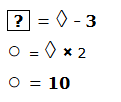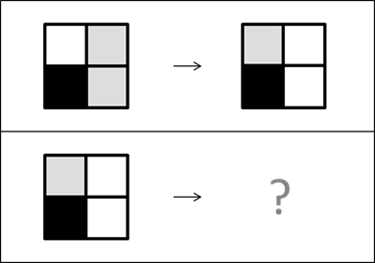The Cognitive Abilities Test (CogAT) is a comprehensive assessment designed to measure students' reasoning abilities across multiple domains. Whether you're preparing your child for gifted program admission or simply want to strengthen their cognitive skills, our free online 9-question diagnostic test provides an excellent starting point. This carefully curated sample covers all major question types from CogAT Level 12 (Form 7), complete with detailed explanations that help you understand not just the answers, but the reasoning behind them.
Looking for a different CogAT Level?
- CogAT Kindergarden — Level 5/6
- CogAT 1st Grade — Level 7
- CogAT 2nd Grade — Level 8
- CogAT 3rd Grade — Level 9
- CogAT 5th Grade — Level 11
- CogAT 6th Grade — Level 12
CogAT Grade 6 Test Format
The CogAT (Cognitive Abilities Test) is divided into three main batteries:
- Assesses language and word relationships
- Includes tests like analogies and sentence completions
- Focuses on numerical reasoning
- Features tasks involving number patterns, puzzles, and mathematical analogies
- Measures reasoning abilities without using language or numbers
- Uses abstract figures for tasks like matrix completion and figure classification
Together, these batteries provide a comprehensive view of a student's cognitive strengths and potential in various reasoning domains. Let's explore each battery through practical examples that mirror what students will encounter on the actual test.
CogAT 6th Grade Verbal Battery-Level 12
Verbal Analogies: Students are presented with pairs of words that have a certain relationship. They must identify another pair of words with the same or a similar relationship. This tests vocabulary, verbal reasoning, and the ability to discern word relationships.
CogAT Grade 6 Verbal Analogies
Find the relationship between the first pair of words, then apply the same relationship to find the word that completes the second pair
vows → wedding : words →
Improve Your CogAT Test Score
Explore our CogAT 6th Grade Packs that include
Realistic Simulations
PrepPacks tailored to accurate test scenarios.
Interactive Tests
Practice materials, designed to help students perform their best on their tests!
Premium Quality
Expert-crafted practice tests with accurate questions and explanations
Sentence Completion: This subtest requires students to choose the word that best completes a sentence. It's testing verbal comprehension, vocabulary, and the ability to understand and complete sentences contextually.
CogAT Grade 6 Sentence Completion
Choose the words that best complete the sentence.
In order for a disagreement to not __________, it is best for people to try to resolve their differences __________.
CogAT Grade 6 Verbal Classification
Three of these words are related in some way. Identify the word that fits with the others
blue cream string
Moving from verbal to numerical reasoning, the Quantitative Battery presents another set of challenging puzzles that test mathematical thinking in different ways.
CogAT Grade 6 Quantitative Battery Level 12
Number Analogies: These questions require recognizing mathematical relationships between numbers, similar to verbal analogies but with numerical concepts. Students must apply the same numerical relationship to find the correct answer.
CogAT Grade 6 Number Analogies
Determine the mathematical relationship between the numbers in the first pair. Then, apply that same relationship to find the number that completes the second pair
[30 → 6] [45 → 9] [50 → ?]
Number Puzzles: Students solve for a missing number in an equation where basic arithmetic operations are used. This tests problem-solving skills, arithmetic operations, and quantitative reasoning.
CogAT Grade 6 Number Puzzles
Solve for the missing number in the equation by applying the correct arithmetic operation(s).

Number Series: Students are shown a sequence of numbers and must determine the next number in the series based on a pattern. This evaluates pattern recognition and mathematical reasoning.
CogAT Grade 6 Number Series
Examine the sequence of numbers. Identify the pattern or rule that governs the series. Then, determine the next number in the sequence.
What number comes next in the series?
12 6 3 24 12 6 48 ?
Boost Your Child's CogAT Scores Today with our Test Prep Pack designed for 6th Grade.
While the previous sections relied on words and numbers, the Non-Verbal Battery takes a different approach, using purely visual reasoning to assess cognitive abilities.
CogAT Grade 6 Non-Verbal Battery Level 12
Figure Matrices: This involves a 2x2 matrix where students must identify the relationship between figures or shapes in one part of the matrix and apply that relationship to choose the correct answer in an incomplete part of the matrix. It measures abstract reasoning and spatial visualization.
CogAT Grade 6 Figure Matrices
Look at the figures in the top row and the left column. They follow a certain pattern or rule. Choose the figure that continues this pattern in the empty box

Paper Folding: Students visualize how a piece of paper would look after being folded and then punched or cut. They must select the correct unfolded result from several options. This tests spatial ability and geometric reasoning.
CogAT Grade 6 Paper Folding
Imagine how the paper looks after it has been folded and then punched with a hole. Select the answer that shows what the unfolded paper would look like with the holes in the correct positions

CogAT Grade 6 Figure Classification
Examine the figures below. Three of them share a common attribute or pattern. Identify and select the figure that belongs with the others.




